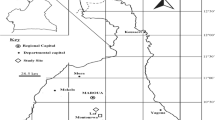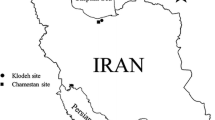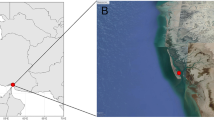Abstract
Quantifying carbon and biomass is relevant information needed in the fight against global warming. Since in Mediterranean ecosystems the agroforestry surface is very large, estimating carbon stocks and their distribution in the different compartments (above ground biomass, root, litter and soil) of these ecosystems is very important. In this work, fixed carbon was quantified in the two most abundant systems of thermophilic shrub of southwestern Iberian Peninsula: Rockroseland (Cistus ladanifer L.) and Broomland (Retama sphaerocarpa L.). Biomass was estimated through regression functions from morphology parameters. The results showed that the distribution of carbon among the compartments depends on the species. It was estimated that 34.7 Mg ha−1 of carbon retained in the C. ladanifer system, distributed among the different reservoirs. The shrub system of R. sphaerocarpa stores 24.3 Mg ha−1 of carbon. The carbon stored in biomass was differently also distributed among its components in each species. In C. ladanifer, carbon in above ground biomass is more than 85 % of the total biomass, and 15 % corresponds to carbon in root. However, in R. sphaerocarpa carbon stored in roots goes up to 48 %. These values show that it is important to quantify the carbon stored in all the components of the ecosystem (including the root), and show how important it is to maintain shrubs as reservoirs of carbon in Mediterranean agroforestry.




Similar content being viewed by others
References
Asner GP (2004) Biophysical remote sensing signatures of arid and semi-arid regions. In: Ustin SL (ed) Remote sensing for natural resources management and environmental monitoring: manual of remote sensing. Wiley, New York, pp 53–109
Bravo F (2007) El papel de los bosques españoles en la mitigación del cambio climático. Fundación Gas Natural, Barcelona
Buras A, Wucherer W, Zerbe S, Noviskiy Z, Muchitdinov N, Shimshikov B, Zverev N, Schmidt S, Wilmking M, Thevs N (2012) Allometric variability of Haloxylon species in Central Asia. For Ecol Manag 274:1–9
Cabezas J, Escudero JC (1989) Estudio termométrico de la provincia de Badajoz. Dirección General de Investigación, Extensión y Capacitación Agrarias, Badajoz
Cairns MA, Winjum JK, Phillips DL, Kolchugina TP, Vinson TS (1997) Terrestrial carbon dynamics: case studies in the former Soviet Union, the conterminous United States, Mexico and Brazil. Mitig Adapt Strat Glob Change 1:363–383
Canellas I, San Miguel A (2000) Biomass of root and shoot sistemas of Quercus coccifera shrublands in Eastern Spain. Ann For Sci 57:803–810
Devesa JA (1995) Vegetación y Flora de Extremadura. Universitas Editorial, Badajoz
Fan JW, Zhong HP, Harris W, Yu GR, Wang SQ, Hu ZM, Yue YZ (2008) Carbon storage in the grasslands of China based on field measurements of above-and below-ground biomass. Clim Change 86:375–396
Fang JY, Chen AP, Peng CH, Zhao SQ, Ci LJ (2001) Changes in forerst biomass carbon storage in China between 1949 and 1998. Sci 292(5525):2320–2322
Figueiredo T (1990) Aplicaçao da equaçao universal de perda de solo na estimativa da erosao potencial: o caso do Parque Natural de Montesinho. ESAB, Bragança
Fonseca W, Alice FE, Rey-Benayas JM (2012) Carbon accumulation in aboveground and belowground biomass and soil of different age native forest plantations in the humid tropical lowlands of Costa Rica. New For 43:197–211
Gayoso J, Schlegel B (2001) Proyectos Forestales para la mitigación de gases efecto invernadero Una tarea pendiente. Ambient Desarro 17(1):41–49
Haase P, Pugnaire FI, Fernández EM, Puigdefábregas J, Clark SC, Incoll LD (1996) Investigation of rooting depth in the semiarid shrub Retama sphaerocarpa (L.) Boiss. by labelling of ground water with a chemical tracer. J Hydrol 177:23–31
Hoffman A, Kummerow J (1978) Root studies in the Chilean matorral. Oecologia 32:57–69
ISO (1994) Organic and total carbon after dry combustion. In: Oostra S, Majdi H, Olsson M (eds) Environment soil quality. ISO/DIS 10694, Geneva
Jackson RB, Mooney HA, Schulze ED (1997) A global budget for fine root biomass, surface area, and nutrient contents. Proc Natl Acad Sci 94:7362–7366
Kimble JM, Lal R, Follett RR (2002) Agricultural practices and policy options for carbon sequestration: what we know and where we need to go. In: Kimbel JM, Lal R, Follett RF (eds) Agricultural practices and policies for carbon sequestration in soil. Lewis Publishers, New York, p 512
Kowalski AS, Loustau D, Berbigier P, Manca G, Tedeschi V, Borghetti M, Valentini R, Kolari P, Berninger F, Rannik E, Hari P, Rayment M, Mencuccini M, Moncrieff J, Grace J (2004) Paired comparisons of carbon exchange between undisturbed and regenerating stands in four managed forests in Europe. Glob Change Biol 10:1707–1723
Kummerow J, Kraus D, Jow W (1977) Root systems of chaparral shrubs. Oecologia 29:163–177
Lamlom SH, Savidge RA (2003) A reassessment of carbon content in wood: variation within and between 41 North American species. Biomass Bioenerg 25:381–388
Lopera G, Gutierrez V (2000) Viabilidad técnica y económica de la utilización de plantaciones de Pinus patula como sumideros de Carbono. Tesis Ingeniero Forestal, Universidad Nacional de Colombia, Medellín
MacClaran MP, Moore-Kucera J, Martens DA, Van Haren J, Marsh SE (2008) Soil carbon and nitrogen in relation to shrub size and death in a semi-arid grassland. Geoderma 145:60–68
MacDiken K (1997) A Guide to monitoring carbon storage in forestry and agroforestry projects. Winrock International, Arlington
Martínez García F, Merino J (1987) Evolución estacional de la biomasa subterránea del matorral del P.N. de Doñana. VIII Bienal Real Sociedad Esp History. Natural 47:263–570
McNaughton SJ, Banyikawa FF, McNaughton MM (1998) Root biomass and productivity in a grazing ecosystem: the Serengeti. Ecology 79:587–592
Metcalfe DB, Kunin WE (2006) The effects of plant density upon pollination success, reproductive effort and fruit parasitism in Cistus ladanifer L. (Cistaceae). Plant Ecol 185:41–47
Miller PC (1977) Root-shoot biomass ratios in shrubs in southern California and Chile. Madroño 24(4):215–223
Mokany K, Raison J, Prokushkin AS (2006) Critical analysis of root: shoot ratios in terrestrial biomes. Glob Change Biol 12:84–96
Nadelhoffer KJ, Raich JW (1992) Fine root production estimates and belowground carbon allocation in forest ecosystems. Ecology 73:1139–1147
Navarro RM, Blanco P (2006) Estimation of above-ground biomass in shrubland ecosystems of southern Spain. Invest Agrar Sist Recur For 15(2):197–207
Nelson DW, Sommers LE (1996) Total carbon, organic carbon, and organic matter. In: Page AL et al (eds) Methods of soil analysis, Part 2, 2nd agronomy. American Society of Agronomy Inc, Madison, pp 961–1010
Nilsson MC, Wardle DA (2005) Understory vegetation as a forest ecosystem driver: evidence from the northern Swedish boreal forest. Front Ecol Environ 3:421–428
Ordóñez JAB, de Jong BHJ, García-Oliva F, Aviña FL, Pérez JV, Guerrero G, Martínez R, Masera O (2008) Carbon content in vegetation, litter, and oil under 10 different land-use and land-cover classes in the Central Highland of Michoacan, Mexico. For Ecol Manage 255:2074–2084
Ortíz E (1997) Costa Rican secondary forest: an economic option for joint implementation initiatives to reduce atmospheric CO2. Draft paper presented for inclusion in the Beijer Seminar in Punta Leona, Mexico
Pastor-López A, Martín J (1995) Ecuaciones de fitomasa para Pinus halepensis en repoblaciones de la provincia de Alicante. Stud Oecol 12:79–88
Patón D, Azocar P, Tovar J (1998) Growth and productivity in forage biomass in relation to the age assessed by dendrochronology in the evergreen shrub Cistus ladanifer L using different regression models. J Arid Environ 38:221–235
Ragland KW, Aerts DJ, Baker AJ (1991) Properties of wood for combustion analysis. Bioresour Technol 37:161–168
Rolo V, Moreno G (2012) Interspecific competition induces asymmetrical rooting profile adjustments in shrub-encroached open oak woodlands. Trees 26:997–1006
Rovira P, Romanya J, Rubio A, Roca N, Alloza JA, Vallejo R (2007) Estimación del carbono orgánico en los suelos peninsulares españoles. In: Bravo F (ed) El papel de los bosques españoles en la mitigación del cambio climático. Fundación Gas Natural, Barcelona, pp 197–292
Rozas MA (1993) Estudio edafológico de la comarca de Jerez de los Caballeros (Spain) PhD thesis. Universidad de Extremadura. Badajoz
Ruiz de la Torre J (1990) Memoria General del Mapa Forestal de España a escala 1:200000. Ministerio de Agricultura, Pesca y Alimentación, Madrid
Ruíz-Peinado R, Moreno R, Juárez E, Montero G, Roig S (2013) The contribution of two common shrub species to aboveground and belowground carbon stock in Iberian dehesas. J Arid Environ 91:22–30
San Miguel A, Roig S, Cañellas I (2008) Fruticeticultura. Gestión de arbustedos y matorrales. In: Serrada R, Montero G, Reque J (eds) Compendio de selvicultura aplicada en España. Arco/Libros, Madrid, pp 877–907
Schlesinger WH (1977) Carbon balance in terrestrial detritus. Ann Rev Ecol Syst 8:51–81
Sierra CA, Harmon ME, Moreno FH, Orrego SA, del Valle JI (2007) Spatial and temporal variability of net ecosystem production in a tropical forest: testing the hypothesis of a significant carbon sink. Glob Change Biol 13:838–853
Silva JS, Rego FC (2004) Root to shoot relationships in Mediterranean woody plants from Central Portugal. Biologia 59(Suppl 13):109–115
Simões MP (2002) Dinâmica de biomassa (carbono) e nutrientes em Cistus salvifolius L. e Cistus ladanifer L. Influência nas características do solo. PhD thesis. Universidade de Évora, Évora
Simões MP, Madeira M, Gazarini L (2009) Ability of Cistus L shrubs to promote soil rehabilitation in extensive oak woodlands of Mediterranean areas. Plant Soil 323:249–265
Sokal RR, Rohlf FJ (1995) Biometry. Freeman, New York, p 887
Titlyanova AA, Romanova IP, Kosykh NP (1999) Pattern and process in above-ground and below-ground components of grassland ecosystems. J Veg Sci 10:307–320
UNFCC (2007) United nations framework convention on climate change, 13th conference of parties to the UNFCCC.
Walkley A, Black IA (1934) An examination of the Degtjareff method for etermining organic carbon in soils: effect of variations in digestion conditions and of inorganic soil constituents. Soil Sci 63:251–263
Yamaguchi DK (1991) A simple method for cross-dating increment core from living trees. Con. J. For Res 21:414–416
Acknowledgments
We thank the Consejería de Economía, Comercio e Innovación de la Junta de Extremadura for their assistance in funding this work (GRU09038) as part of the “Plan for the Consolidation of and Support to Research Groups”. Special thanks to Manuel Mota (statistician) for valuable statistical analysis.
Author information
Authors and Affiliations
Corresponding author
Rights and permissions
About this article
Cite this article
Alías, J.C., García, M., Sosa, T. et al. Carbon storage in the different compartments of two systems of shrubs of the southwestern Iberian Peninsula. Agroforest Syst 89, 575–585 (2015). https://doi.org/10.1007/s10457-015-9792-z
Received:
Accepted:
Published:
Issue Date:
DOI: https://doi.org/10.1007/s10457-015-9792-z




